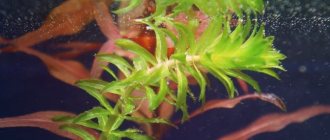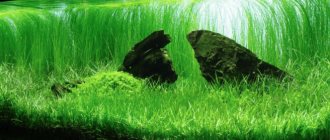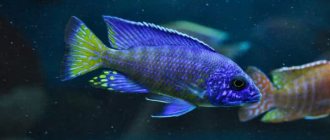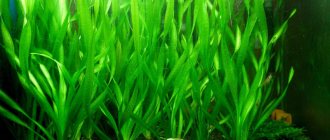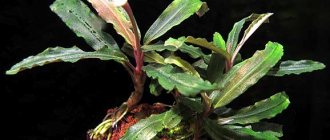Botanical properties
Echinodorus (from Latin Echinodorus) is a perennial marsh herbaceous plant with leaves of various shapes, sizes and colors. A typical species characteristic is the presence or absence of a transparent (and sometimes darker than the base) color pattern consisting of lines or dots. Being a rather unpretentious plant in terms of water hardness, pH level and temperature, it is tolerant of changes, which is why it is easy to grow, and some varieties even feel comfortable on land.
The sizes of Echinodorus vary from a few centimeters to one and a half meters in height, depending on the species and conditions of detention. During the flowering period, it forms a long peduncle with a small inflorescence at the top.
Distinctive features of plants
All species of Echinodorus do not have a stem. The leaves grow from the rhizome, on which thickenings are formed followed by the development of buds. In the future, but only under good conditions, new plants can begin to develop from the buds. Thus, vegetative propagation of plants occurs.
The leaves of Echinodorus are dense, and their shape can be different: oval, spear-shaped, round, heart-shaped, linear. The color of the leaves, as well as their shape, can also vary, ranging from soft green to red.
Under good conditions in the aquarium, Echinodorus can bloom. A peduncle is thrown into the water, at the end of which an inflorescence is visible. Branches and leaves form on the peduncle, and over time a root appears. New plants can be separated from the mother bush and planted in a new location.
Under natural conditions, Echinodorus can reproduce by seeds. This is incredibly difficult to do in an aquarium.
Mr. Tail recommends: Echinodorus species
The most popular varieties of Echinodorus.
Amazonian
Amazonicus is a dense bush-like growth of green elongated leaves up to 40 cm in height and up to 4 cm in width. Growth is uniform all year round. Intense sunlight is desirable, but tolerates partial shade. The soil layer must be at least 5 cm (fine gravel or coarse sand).
Cordifolia
Cordifolius is a fairly large, hard-leaved, marshy plant with sweeping green, sometimes red dotted, ovoid leaf blades, the apex of which is pointed or rounded, with a pronounced vein pattern and a heart-shaped base. An excellent choice for large aquariums, the recommended minimum of which is 200 liters. With 8 hours of daylight, it grows only under water, reaching 30 cm; when increased to 11, it begins to develop wildly, forming airy and floating leaves up to 80 cm high, and even bloom. Care includes periodic trimming by removing large leaves.
Rose
Rose is a hybrid up to 25 cm in height and up to 40 cm in diameter. The leaves are narrow, elliptical in green shades, sometimes with dark red splashes. Young shoots are pink in color. Needs regular feeding.
Red Devil
Red Devil is a bush 25 cm in diameter. Green, lanceolate-shaped leaf blades that tend to curl. The difference between the young shoots is their bright ruby color. Requires nutritious, well-silted soil. Sand is suitable as a base, but it is advisable to place a little clay under the plant.
Ruby
Rubin is a large hybrid. The recommended aquarium is at least 300 liters. Narrow, sometimes ribbon-shaped leaves up to 35 cm, on a high petiole up to 25 cm. There is a smaller variation - Narrow leaves, the bright red leaves of which have lighter veins than those of their older brother, and up to 20 cm in height. Requirements: increased lighting, nutritious soil, periodic application of fertilizers.
Dark Beauty
Dark Beauty is a small rosette up to 20 cm, with oval purple leaves. The young shoots are a rich burgundy color. Requires intense light, moderately nutritious substrate.
Ocelot
Ozelot is a medium-sized crop developed through selective breeding. Its color comes in two types: brown with dark red splashes and light green with brown specks. Peduncles are emergent. Unpretentious to lighting. Water of any hardness, neutral pH.
Saint Elmo's Fire
Sankt Elmsfeuer is a medium-sized hybrid, up to 30 cm. The leaves are ellipsoidal, up to 5 cm wide, the color of which varies from olive to bright red with small dots. Young shoots are purple in color, sometimes to shades of eggplant color, thereby reminiscent of St. Elmo's fire. Illumination is average.
Vesuvius
Vesuvius is characterized by narrow, ribbon-like leaves of a bright green color that tend to curl. The height of the rosette is up to 15 cm. To maintain its unique decorative properties, it requires intense lighting and a stable habitat. The soil should be nutritious and well silted.
Gentle
Tenellus (tenellus, herbaceous) differs from other varieties of Echinodorus in its small size (up to 6 cm) and the absence of rhizomes. Narrow green leaves up to 10 cm long and 1-3 mm wide. A fast-growing plant, ideal for both small-sized aquariums and the front part of large ones. Light-loving, picky about the soil: substrate of small fractions with a height of at least 2 cm.
Rubra
Tenellus rubra. He is also the Dwarf Chainsword. Narrow, up to 2 mm, elongated leaf plates up to 7 cm long, dark green. Under optimal conditions, young shoots have purple hues. Requires intense lighting and fine nutrient soil.
Quadricostatus
Quadricostatus is a small broad-leaved shrub of bright green color, up to 15 cm, perfect for the design of an aquarium of any size. Light – from moderate to intense. Requires nutritious soil and fertilizing with iron.
Reiners Felix
Rainer's Felix - small in size, up to 10 cm in diameter. Green shoots with red-brown pigment. Young sprouts have a golden hue and a more distinct pattern. Ideal for nano aquariums. Lighting – from moderate to intense. Requires nutritious soil and CO2 feeding.
Narrow-leaved
Angustifolius forms medium-sized bushes. Narrow ribbon green leaf blades up to 60 cm long, up to 4 mm wide. Prefers bright sunlight. Excellent tolerance to water of any hardness. A neutral pH is required.
Horizontal
Horizontally is a stemless horizontal plant with a strong root system. Color changes depending on age: from brown to light green. Lighting is average.
Blehera
Bleheri. He is also a yarrow. It is similar in appearance to the Amazon variety, but its leaves are wider (up to 8 cm) and straighter. A lush, bushy, stemless plant, up to 60 cm high, dark green in color. Unpretentious in lighting. Substrate - crushed gravel of at least 5 cm, under the rhizome - small pieces of clay. In this case, the crop can be planted in a separate pot, at the same time ensuring a good soil level. With a lack of iron, the leaves turn yellow.
Argentinian
Argentinensis is a giant representative of Echinodorus, reaching a height of over a meter in good swampy conditions, and about half a meter in an aquatic habitat. Dense dark green leaves of various shapes: round, oval, pear-shaped, elongated, etc. The soil is at least 5 cm thick.
Uruguayan
Uruguayensis is a large bush with long, elongated dark green leaves, up to half a meter high, up to 4 cm wide. It does not form an aerial part. Requires a nutrient substrate: sand, gravel.
Latifolius
Latifolius (Dwarf sword) is a dense bush-like plant with a powerful rhizome and narrow elongated light green leaf blades. It can reach a height of 15 cm. Requires intense lighting and additional CO2 supply. The soil is fine gravel or sand, at least 3 cm high. With a lack of iron, the leaves turn yellow.
Maghrebi
The Maghribian is a medium-sized hybrid. The recommended minimum aquarium size is 30 liters, up to 30 cm in diameter. Young shoots are dark pink, while mature leaves become browner. Both have wavy edges and an elongated shape.
Python
Python is a large crop, reaching half a meter in height and 40 cm in width. Dense broad-leaved rosette of green color with a brown tint. Young shoots are light cherry with dark pigment. Requires intense lighting, nutritious soil, and fertilizing.
Schluter
Schlueteri is distinguished from other varieties by small bright green ellipsoidal leaves with reddish inclusions. Slow growing crop up to 20 cm in height. Requires moderate light and nutritious soil.
Red Pearl
Hadi Red Pearl is a compact plant up to 20 cm. An excellent aquarium inhabitant even for small tanks, from 40 liters. Green wide leaves ellipsoidal in shape. Young shoots are bright red in color, based in the center of the rosette. The water is soft, acidity 6-7.5 pH.
Nazgul
Nazgul is a large hybrid, up to half a meter. The leaves are green with purple dots. The young shoots, like the peduncle, are bright pink. Requires intense lighting and moderately nutritious soil.
Osiris
Osiris. He is also Echinodorus orientalis. A hybrid with narrow long (up to 30 cm) ellipsoid or lanceolate leaves. The color depends on the conditions of detention and ranges from olive to brown-red.
Aflame
Aflame is a compact crop with large bright burgundy lance-shaped leaf blades up to 25 cm high. Intense lighting (at least 0.7 W/l), daylight hours up to 14 hours. Nutritious soil, regular fertilizing.
Hildebrandt
Regine Hildebrandt is a bush-like hybrid with cherry-colored leaves up to 20 cm in length. More mature ones acquire a brown tint, and then turn completely green. Light – moderate or intense.
Veronica
Veronicae (Florence) is a large, dense, rosette-type hybrid with narrow lanceolate leaves up to 40 cm in length, green or olive in color. Young shoots are red in color. Can form the surface part. The lighting is intense. Well silted soil.
small-flowered
Parviflorus (Black Amazon). Thick dark green leaves with dark brown veins, elongated, up to 40 cm long.
Mottled
Aspersus is a low-growing, broad-leaved, bushy plant. The leaves are green with brownish splashes, reach 10 cm in length and 6 cm in width, forming a dense dense rosette up to 20 cm in diameter.
Small bear
Kleiner Baer is a large, dense, broad-leaved hybrid, up to 40 cm high. Green leaves are ellipsoidal, wavy at the edges. Young shoots are light red in color. The lighting is intense. Requires nutritious, heavily silted soil of fine fractions.
Tenelli Fasset
The first section of the genus Echinodorus is characterized by the following characteristics: flowers have no more than 20 pistils (usually fewer), the ribs on the seeds are smooth and never jagged, the shape of the leaf blades is linear-spear-shaped to narrow-elliptical, there are 6-9 stamens. This section contains dwarf species of the genus Echinodorus, which are distributed from the temperate zone of the United States to the temperate zone of Argentina. In the tropics these species are most often perennial; in the middle zone they are usually annual. The flowers are relatively small and reach a diameter of 0.6-1.5 cm. Species belonging to section Tenelli are the only members of the genus that, like plants from the genera Sagittaria and Vallisneria, reproduce by stolons and often form above- or underwater green thickets consisting of many hundreds of plants. The formation of young plants on peduncles occurs relatively rarely. All species form surface and underwater forms that differ from each other. They grow in damp places, in periodically flooded places, or constantly under water. In permanent underwater culture, these species do not bloom, remaining sterile, and reproduce exclusively by vegetative means. Studying these species using herbarium materials is very difficult. On dry plants it is only possible, and even then with difficulty, to recognize the most important characteristics, for example, the size of the corolla.
The section contains 6 types:
1. Echinodorus tenellus 2. Echinodorus isthmicus (Fasset) 3. Echinodorus austroamericanus (Rataj) 4. Echinodorus latifolius (Seubert) (Rataj) 5. Echinodorus angustif olius (Rataj) 6. Echinodorus quadricostatus (Fasset)
SECTION II
Difficulties in care, planting and reproduction
Being generally hardy representatives of the plant world, Echinodorus are rarely susceptible to disease, but there are still certain difficulties when caring for this type of plant. A number of requirements include:
- Intense lighting (for some - over 0.7 W/l; extended daylight hours up to 11-14 hours).
- Nutritious fine fraction substrate (sand or pebbles with or without the addition of pieces of clay and boiled peat under the rhizome, depending on the root system). Often among the descriptions of conditions there is well-silted soil of a certain height. They require periodic application of microfertilizers (selected strictly individually), and some require additional CO2 supply.
- Regular replacement of part of the water, cleaning of the soil.
- Temperature – most often +20…+28 °C. Neutral pH, medium water hardness. However, there are individual preferences.
- It is advisable to periodically replant the plant. At the same time, varieties with a powerful rhizome require more frequent replanting than those that do not form one.
Propagation mainly occurs by daughter plants, but some species are still capable of propagation by seeds and (or) division of rhizomes.
Origin
The Echinodorus variety Kleiner Bar Sword is a hybrid; it appeared relatively recently. This hybrid was bred in the 90s from two species of South American echinodorus from the Amazon basin, Echinodorus uruguayensis and Echinodorus barthii. Thanks to the species Echinodorus barthii, the hybrid received large, juicy green oval-elliptical leaves, and the original plant Echinodorus uruguayensis gave the hybrid a reddish tint of adult leaves. Since 1995, the modern hybrid Echinodorus Kleiner Bar Sword has been successfully grown in the German nursery Dennerle.
Compatibility
When starting to plant Echinodorus in an artificial reservoir, you should take into account its compatibility with other types of flora. Thus, when selecting according to the requirements of lighting, temperature and other important indicators of the habitat, you should definitely take into account the size of the final form in order to avoid further shading and/or displacement of the crop.
It is not particularly recommended to plant it next to Cryptocoryne, but Sagittaria will make a pretty good neighbor.
Echinodorus is an excellent choice for landscaping aquariums, including cichlids, as well as paludariums, terrariums and even greenhouses, becoming not only an indispensable decorative element, but also a complete shelter and source of oxygen for both fish and amphibians and reptiles.
How to plant
Planting Echinodorus is a simple task that even novice aquarists can handle. There are 2 ways to plant a plant:
- The first is to make a small hole in the ground and plant a small bush in it, pressing it down with decorative stones for better rooting.
- Professionals advise planting Echinodorus in an aquarium with the roots immersed in soil that is already familiar to the plant.
The best soil for this aquarium plant is purified river sand and gravel.
Be sure to add mineral fertilizers to the soil before planting.
Echinodorus is a very beautiful and spectacular aquarium plant that allows you to create a unique design. A huge selection of varieties that differ in size, color, shape, and maintenance conditions allows every aquarist to choose the best option for himself.
Useful lifehacks
To promote better plant growth, we offer advice from experienced aquarists:
- "Red Devil" looks impressive in . But when planting at the same time, it should be taken into account that the latter hybrid has a slower growth rate.
- To prevent the death of a purchased plant after planting it in an aquarium, it is necessary to buy eichnodorus grown under conditions of complete immersion.
- Most Echinodorus are susceptible to algae fouling. This is due to the fact that plants prefer bright light.
- In soft water, the Red Devil may experience mineral starvation. To prevent this, you should use combined supplements containing all the necessary microelements.
- Since guppies, swordtails and most popular aquarium fish love to feast on Echinodorus, it is better to grow the plant in the company of the less voracious fish Vacuum.
Distribution area
They grow naturally over a large area, including the center of North America, Colombia, Argentina and Cuba. But most members of the genus prefer the unique flora and fauna of the Amazon.
Echinodorus are bog crops. They grow both in air and submerged in water. The main condition for good growth is good illumination of the area. Prolonged shading leads to the death of plants.
Feeding the speckled corydoras
Speckled catfish are completely picky eaters and eat everything that falls to the bottom of the aquarium. Although they are able to swim to the surface to eat floating food, fish are more comfortable feeding near the bottom. It is best to use special sinking tablets for catfish for feeding. They quickly sink to the bottom and retain their shape for a long time. To avoid accidentally introducing an infection into the aquarium, it is better to avoid using live and frozen food.
Tetra Cory ShrimpWafers, designed specifically for all species of corydoras, are a good choice for feeding speckled catfish. Shrimp-rich food is rich in essential omega-3 fatty acids to promote healthy growth. Thanks to their special consistency, the plates do not pollute the water.
We also recommend paying attention to universal food for all types of bottom fish - Tetra Tablets TabiMin, Tetra Wafer Mix. Thanks to the content of ingredients of both animal and plant origin, the food fully satisfies the nutritional needs of catfish, ensures healthy growth and longevity
It is better to feed Corydoras in the evening, after turning off the lights.
Appearance
Corydoras have a body shape typical of armored catfish. It is dense, compressed in width, with a characteristic convex back. On the sides of the body there are two rows of dense bony plates, which serve as protection from predators, but make the fish a little clumsy.
The mouth is lower, with three pairs of sensitive antennae, which help Corydoras to dig in the ground and navigate in muddy water. The eyes are large and mobile. The dorsal fin is high, the adipose and pectoral fins have spines, so you need to be careful when catching catfish with a net.
Speckled catfish. Appearance
The main body color is greenish-gray and has a large number of spots forming a speckled pattern, for which the fish received its specific epithet. The abdomen is light, with a golden tint. The fins are transparent and speckled. Albino (white body and red eyes) and veiled forms with highly developed fins were bred.
The body length of the male is 4-6 cm, the female is larger - up to 7 cm.


